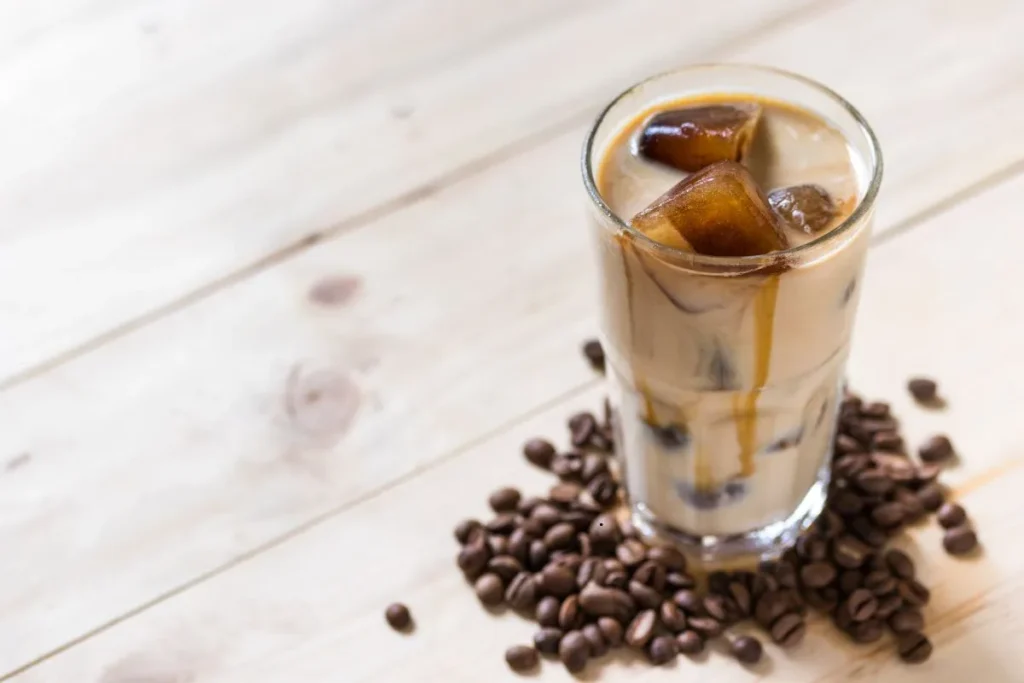Introducing the world of Spanish lattes, where silky milk combines with creamy espresso and a hint of sweetness. This cherished beverage, which has captured the attention of coffee lovers worldwide with its smooth texture and rich flavor profile, originated in the vibrant coffee culture of Spain.
It’s not as hard as you might think to become an expert at making a Spanish latte at home, even if you’re not a coffee enthusiast.
What is Spanish Latte
A Spanish Latte is a popular coffee drink that combines the rich, creamy texture of a latte with the bold, intense flavor of Spanish coffee. This unique beverage is typically made by combining freshly brewed espresso with steamed milk and a generous amount of sweetened condensed milk, which gives it a distinctive taste and velvety smooth consistency.
The use of sweetened condensed milk is what sets the Spanish Latte apart from a traditional latte. Spanish Latte Recipe. Condensed milk is made by removing water from regular milk and adding sugar, resulting in a thick, sweet, and concentrated dairy product. When added to the espresso and steamed milk, it creates a decadent, indulgent flavor profile that is both sweet and coffee-forward.
Spanish Lattes are often served over ice, making them a refreshing and satisfying choice for hot summer days. The combination of the chilled, creamy beverage and the bold coffee flavor is both refreshing and energizing. Some variations of the Spanish Latte may include additional flavors, such as vanilla or caramel, which can be added to the sweetened condensed milk for an extra layer of sweetness and complexity.
Whether enjoyed hot or iced, the Spanish Latte is a delightful treat for coffee lovers who appreciate a sweet and creamy twist on the classic latte. Its unique flavor profile and smooth texture make it a popular choice among coffee enthusiasts around the world.
Spanish Latte Flavor Profile
The Spanish latte boasts a unique and captivating flavor profile that sets it apart from traditional coffee beverages. Let’s explore the key elements that contribute to its distinct taste:
Bold Espresso Base
At the heart of the Spanish latte lies a strong, robust espresso foundation. The concentrated coffee provides a deep, rich flavor with subtle notes of bitterness that cut through the drink’s sweetness.
The quality and freshness of the coffee beans significantly impact the overall taste. Look for beans with a medium to dark roast profile, as they tend to have a more pronounced and complex flavor that can stand up to the addition of milk and condensed milk.
Creamy Condensed Milk Sweetness
The incorporation of sweetened condensed milk is what truly defines the Spanish latte’s flavor. This thick, syrupy ingredient adds a luscious, caramel-like sweetness that perfectly complements the bold espresso.
The condensed milk also contributes to the drink’s smooth, velvety texture, creating a luxurious mouthfeel that coats the palate and lingers pleasantly.
Harmonious Milk Integration
The steamed milk serves as a bridge between the intense espresso and the sweet condensed milk, balancing the flavors and creating a harmonious unity. The milk’s natural sweetness and creaminess soften the espresso’s edges, while its subtle dairy notes add depth and complexity to the overall taste profile.
Customizable Sweetness Level
One of the beauties of the Spanish latte is the ability to adjust the sweetness to suit individual preferences. By varying the amount of condensed milk used, you can achieve a range of flavors from mildly sweet to indulgently decadent.
This adaptability allows the Spanish latte to cater to a wide range of palates, from those who prefer a more subdued sweetness to those with a strong sweet tooth.
Optional Flavor Enhancements
While the core flavor profile of the Spanish latte is centered around the espresso, condensed milk, and regular milk, there’s room for additional flavor enhancements.
A sprinkle of cinnamon or cocoa powder on top can add a warm, aromatic dimension to the drink, while a splash of vanilla or hazelnut syrup can provide an extra layer of sweetness and depth.
Comparison to Other Coffee Drinks
Compared to a classic latte, the Spanish latte offers a more pronounced sweetness and a thicker, creamier texture due to the addition of condensed milk. In contrast to a Cuban latte, which typically uses a higher ratio of espresso to milk and may include additional sugar, the Spanish latte achieves its sweetness primarily through the use of condensed milk, resulting in a more balanced and nuanced flavor.
Spanish Latte Ingredients
To craft the perfect Spanish latte, you’ll need the following key components:
Espresso
- High-quality espresso is crucial for achieving the bold, rich flavor that defines this drink.
- Opt for freshly ground beans sourced from reputable origins like Spain, Cuba, Brazil, or Indonesia.
- Aim for a medium to dark roast profile to complement the sweetness of the condensed milk.
Milk
- Whole milk is the traditional choice, offering a creamy texture and balanced taste.
- For a lighter option, 2% or skim milk can be substituted, although the mouthfeel may be slightly compromised.
- Plant-based alternatives such as oat, almond, or coconut milk are suitable for vegan or dairy-free diets.
Sweetened Condensed Milk
- This thick, syrupy ingredient is the hallmark of a Spanish latte, providing a distinct sweetness and velvety consistency.
- Adjust the amount according to personal preference, starting with 1-2 tablespoons per serving.
- Look for high-quality brands or consider making your own condensed milk for ultimate control over the ingredients.
Optional Add-ins and Toppings
- Granulated sugar or flavored syrups can be used to fine-tune the sweetness level.
- Ground cinnamon or cocoa powder can be sprinkled on top for an extra layer of flavor and visual appeal.
- A dollop of whipped cream adds a luxurious finishing touch, especially for those with a sweet tooth.
Equipment Needed
To successfully prepare a Spanish latte in your own kitchen, you’ll need the following essential tools:
Espresso Machine or Alternative Brewing Method
An espresso machine is the ideal choice for pulling high-quality shots with the perfect crema. If you don’t have an espresso machine, you can use a stovetop Moka pot, AeroPress, or French press to brew a strong, concentrated coffee as a substitute.
Milk Steaming Pitcher
A stainless steel pitcher with a tapered spout is essential for steaming and frothing milk. Choose a size appropriate for the number of servings you plan to make, typically ranging from 12 to 20 ounces.
Thermometer
A thermometer helps ensure that your milk is heated to the optimal temperature range of 150-160°F (65-70°C) for the best texture and flavor. An instant-read thermometer or a milk frothing pitcher with a built-in temperature gauge are both suitable options.
Coffee Grinder
Freshly ground coffee is key to achieving the best flavor and aroma in your Spanish latte. Invest in a high-quality burr grinder for consistent, even grinding results.
Scale and Measuring Spoons
A digital kitchen scale allows for precise measurement of coffee grounds, ensuring a balanced extraction. Measuring spoons are handy for accurately dosing the condensed milk and any other add-ins.
Serving Glasses or Mugs
Choose heat-resistant glasses or mugs that showcase the stunning layered appearance of the Spanish latte. Clear glasses are ideal for iced versions, while ceramic or glass mugs are perfect for hot servings.
Spanish Latte Recipe – Step-By-Step Instructions

Follow these detailed steps to prepare a delightful Spanish latte:
Grind the coffee beans
Using your burr grinder, freshly grind the appropriate amount of coffee beans for a double shot of espresso (typically 18-21 grams). Adjust the grind size to achieve a fine, espresso-suitable consistency.
Dose and tamp
Transfer the ground coffee into the portafilter, ensuring an even distribution. Use a tamper to firmly press down on the grounds, creating a level and compact puck.
Pull the espresso shots
Securely lock the portafilter into your espresso machine’s group head. Place a preheated espresso cup or shot glass beneath the spout. Initiate the brewing process and extract two shots of espresso (approximately 2 ounces or 60 ml) within 25-30 seconds.
Scald the milk
While the espresso is brewing, pour the desired amount of milk into your steaming pitcher. Using the steam wand of your espresso machine or a stovetop method, heat the milk to a temperature between 150-160°F (65-70°C), monitoring it closely with a thermometer. For a velvety microfoam, ensure the tip of the steam wand is just below the milk’s surface, creating a gentle whirlpool effect.
Combine the components
Pour the freshly brewed espresso into your chosen serving glass or mug. Measure out the desired amount of sweetened condensed milk (start with 1-2 tablespoons) and add it to the espresso. Stir gently to incorporate the condensed milk, ensuring a smooth and well-blended mixture.
Add the steamed milk
Slowly pour the scalded milk over the espresso and condensed milk mixture, using a spoon to retain the foam if desired. The key is to create a harmonious balance between the bold espresso, sweet condensed milk, and creamy steamed milk.
Customize and garnish
If you prefer additional sweetness, you can stir in a touch of granulated sugar or your favorite flavored syrup at this stage. For a visually appealing presentation, use a spoon to add a layer of foam to the top of your Spanish latte. Optional: Dust the foam with a sprinkle of ground cinnamon or cocoa powder for an extra aromatic touch.
Serve and enjoy
Your Spanish latte is now ready to be savored. Serve it immediately to appreciate the perfect balance of flavors and textures. For an iced version, simply pour the combined espresso, condensed milk, and milk over a glass filled with ice cubes, stirring to chill and combine the ingredients thoroughly.
Spanish Latte Variations and Adaptations
One of the beauties of the Spanish latte recipe is its versatility, allowing for numerous variations and adaptations to suit individual preferences and dietary requirements. Consider the following ways to customize your Spanish latte:
Milk Alternatives
Experiment with various plant-based milk options, such as almond, oat, coconut, or soy milk, to create a dairy-free or vegan-friendly version of the Spanish latte. Each alternative milk will contribute its unique flavor and texture to the final drink, so explore different options to find your preferred combination.
Sweetness Level
Adjust the amount of sweetened condensed milk to suit your taste preferences. Start with a smaller quantity and gradually increase it until you achieve the desired level of sweetness. For a less sweet alternative, you can use unsweetened condensed milk or substitute it with a sugar-free syrup or sweetener.
Flavored Syrups
Add a pump or two of your favorite flavored syrup to the Spanish latte for an extra layer of taste. Popular options include vanilla, caramel, hazelnut, or even seasonal flavors like pumpkin spice or peppermint mocha. Be mindful of the sweetness level when combining flavored syrups with the already sweet condensed milk.
Spices and Garnishes
Sprinkle a pinch of ground cinnamon, nutmeg, or cardamom on top of your Spanish latte for a warming, aromatic touch. Create a visually appealing garnish by dusting the foam with cocoa powder, drizzling caramel sauce, or adding a cinnamon stick for a stirring effect.
Iced Spanish Latte
Transform your Spanish latte into a refreshing iced beverage by combining the espresso, condensed milk, and cold milk over a generous amount of ice cubes. Adjust the proportions slightly to accommodate for ice melt, ensuring a well-balanced flavor profile.
Decaffeinated Option
For those sensitive to caffeine or looking to enjoy a Spanish latte in the evening, swap regular espresso with a decaffeinated version. Ensure you use high-quality decaffeinated coffee beans to maintain the rich flavor and aroma of the drink.
Alcoholic Twist
Create an indulgent, adult-only treat by adding a shot of your favorite liqueur to the Spanish latte. Kahlúa, Bailey’s Irish Cream, or rum can add a delightful boozy kick to the drink. Remember to enjoy responsibly and adjust the sweetness level accordingly.
Troubleshooting and Tips
Even with a well-crafted recipe, achieving the perfect Spanish latte may require some practice and troubleshooting. Keep these tips in mind to ensure a smooth and enjoyable brewing experience:
Achieving the Perfect Milk Texture
When steaming milk, aim for a smooth, velvety microfoam rather than large, stiff bubbles. Keep the steam wand tip just below the milk’s surface, creating a gentle whirlpool motion to incorporate air evenly. Avoid overheating the milk, as temperatures above 170°F (76°C) can cause scalding and result in a burnt taste. Use a thermometer to monitor the temperature closely.
Avoiding Over-Extraction
Over-extracted espresso can lead to a bitter, unpleasant taste in your Spanish latte. Ensure that your espresso shot pulls within the recommended 25-30 second range for optimal flavor. Adjust the grind size and tamp pressure if needed to achieve the proper extraction time and a balanced taste profile.
Mastering Latte Art
While not essential to the taste, latte art can add a beautiful and impressive touch to your Spanish latte presentation. Start by perfecting your milk steaming technique, as the quality of the microfoam directly impacts the success of your latte art. Practice simple designs like a heart or rosetta, and gradually work your way up to more intricate patterns as your skills improve.
Maintaining Consistency
Use a scale to accurately measure your coffee grounds and condensed milk for each serving, ensuring a consistent flavor profile every time. Keep your equipment clean and well-maintained to prevent any off-flavors or residue from affecting the taste of your Spanish latte.
Experimenting with Coffee Beans
The quality and freshness of your coffee beans significantly influence the final taste of your Spanish latte. Experiment with different roasts, origins, and blends to find the perfect match for your palate. Store your beans in an airtight container in a cool, dark place to maintain their freshness and flavor.
Adjusting for Batch Servings
When preparing Spanish lattes for a group, adjust your recipe proportions accordingly to maintain the proper balance of ingredients. Consider using a larger steaming pitcher and pulling multiple espresso shots simultaneously to streamline the process and ensure consistent quality.
Reheating and Storage
While it’s best to enjoy your Spanish latte immediately after preparation, you can store any leftover coffee in an airtight container in the refrigerator for up to 24 hours. To reheat, warm the mixture gently in a microwave or on the stovetop, stirring frequently to avoid scorching. Note that the texture and flavor may slightly diminish compared to a freshly made Spanish latte.
Conclusion
Crafting your own Spanish latte at home not only brings the flavors of Spain to your kitchen but also allows you to personalize each cup to your liking. You may have creamy, delicious coffee that rivals your favorite café by following the instructions and experimenting with different variants. Embrace the richness of espresso, the sweetness of condensed milk, and the frothy goodness of steamed milk in every sip of your homemade Spanish latte.
You can also try these recipe that you will love Wawa Chicken Noodle Soup Recipe and Wawa Chicken Salad Recipe.
Frequently Asked Questions
Q1: What is the difference between a Spanish latte and a regular latte?
A Spanish latte differs from a regular latte in its use of sweetened condensed milk, which adds a distinct sweetness and creaminess to the drink. Additionally, Spanish lattes often have a higher ratio of espresso to milk compared to regular lattes.
Q2: Can I make a Spanish latte without an espresso machine?
While an espresso machine is the ideal tool for making a Spanish latte, you can still achieve a similar result using alternative brewing methods such as a Moka pot, French press, or AeroPress. These methods produce a strong, concentrated coffee that can be used as a base for your Spanish latte.
Q3: Is a Spanish latte sweet?
Yes, a Spanish latte tends to be sweeter than a regular latte due to the addition of sweetened condensed milk. However, the level of sweetness can be adjusted to personal preference by varying the amount of condensed milk used.
Q4: Are Spanish lattes high in calories?
Spanish lattes can be higher in calories compared to regular lattes because of the added sugar and fat content from the sweetened condensed milk. To reduce the calorie count, you can use less condensed milk or opt for a low-fat or non-dairy milk alternative.
Q5: Can I make a vegan Spanish latte?
Absolutely! To create a vegan version of a Spanish latte, simply replace the regular milk with your preferred plant-based milk alternative, such as almond, oat, or soy milk. You can also use vegan-friendly condensed milk or a sweetener like maple syrup or agave nectar.

Rossi Glover, the passionate Owner of Grand Lake Coffee, infuses every cup with her love for coffee and dedication to quality. With an extensive background in the art and science of coffee, Rossi is not just a connoisseur but a storyteller, sharing the intricate tales behind each brew.

